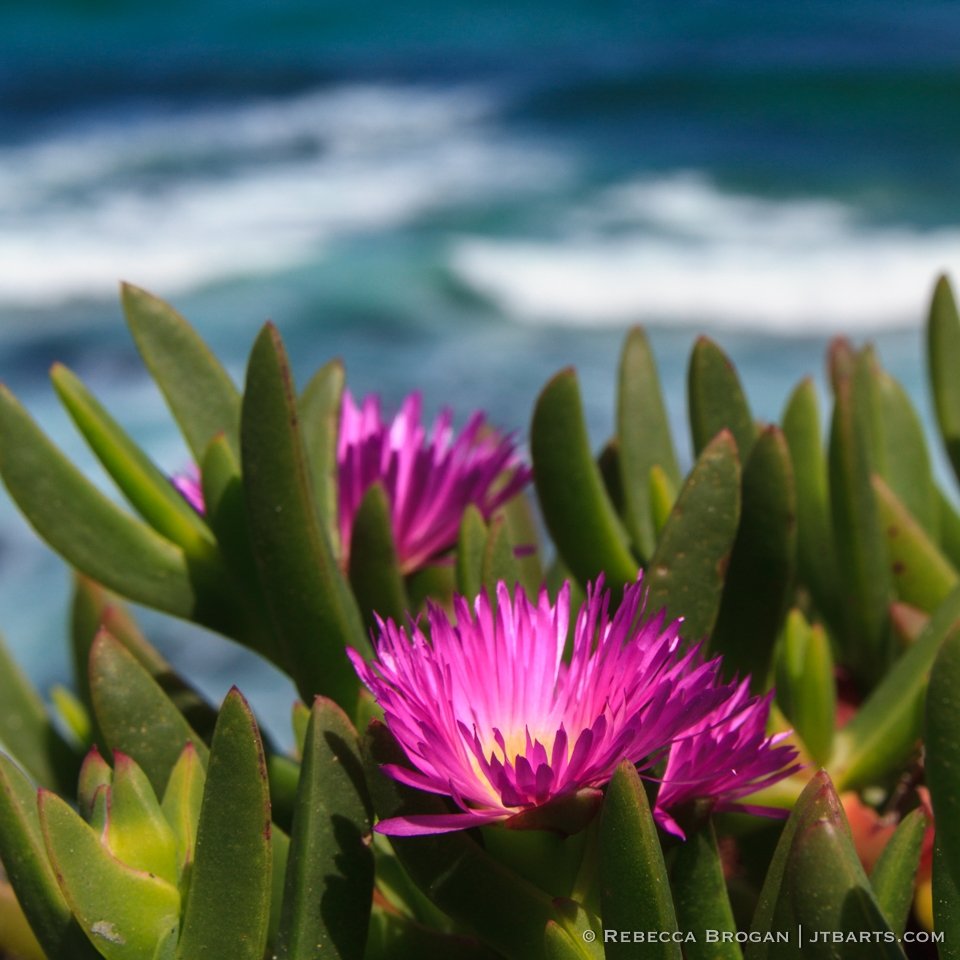LANDSCAPE PHOTOGRAPHY > SOUTHWEST NATIONAL PARK – SOUTH COAST TRACK REGION – TASMANIA > Pig Face Flowers (Carpobrotus rossii) (South Cape Bay, South Coast Track, Southwest National Park)
PURCHASE PRINT – Print Code: SWSCT1
Print Sizes: S, M, L, Oversize
Native pig face (carpobrotus rossii) is the only species of pig face native to Tasmania, hence the name. As a succulent, they store water in their stems in order to survive in salty, coastal regions. Their leaves, flowers and fruit are edible and were used for food and medicine by the Tasmanian aborigines. Its floral peak usually extends from mid November to mid December. It is found in great masses along the sand dunes and rocks at South Cape Bay.
South Cape Bay is the southernmost point of Australia and is located within Tasmania’s Southwest National Park World Heritage Area. South Cape Bay can be accessed by either the easy way or the hard way. The easy way is to start at Cockle Creek and walk for a couple of hours over relatively flat terrain with variable scenery through dry eucalypt forests, marshy heathlands and coastal shrub. The hard way is to fly into Melaleuca and walk for seven days (74 km (46 mi)) on Tasmania’s famous “South Coast Track”.
Southwest National Park World Heritage Area is Tasmania’s largest park at 6183 square km (2387 square mi). With its jagged quartzite mountain peaks, battered coastlines and buttongrass moorlands, it is Tasmania’s most remote, wild and rugged wilderness.
Photographer’s Reflection:
“…we also rejoice in our sufferings, because we know that suffering produces perseverance; perseverance, character; and character, hope. And hope does not disappoint us [believers], because God has poured out his love into our hearts by the Holy Spirit, whom he has given us.” (Romans 5:3-5)
I was on my way back to Cockle Creek after a quick overnight backpacking trip to South Cape Bay. Just as I was about to turn my back on the rugged southern coastline and head back inland I noticed a small handful of pig face flowers blooming ever so happily on top of the rocky cliffs above South Cape Bay. Far down the other side of the cliffs, huge 5m (16.3’) waves thundered onto shore.
I sat there for a couple of minutes simply appreciating and admiring these hardy, happy little flowers. They endure far more than what meets the eye. They bear the brunt of the ferocious winds of the ‘Roaring 40’s’, winds that lash Tasmania’s south coast with gusts in excess of 100 kph (62 mph). They endure days of rain and squalls coming off of the wild Southern Ocean as well as the baking Australian sun, and last but not least, careless humans who have a tendency to pick them and trample them underfoot.
Though I was only observing these hardy little flowers in this one moment in time, I reflected upon their full lifetime. Despite all the hardships they had endured, nevertheless, there they stood, joyful, vibrant and resilient.
What a testimony to us all. At the end of our lives will we be weathered down, cynical and grumpy from all the difficulties we’ve faced in life? Or will we allow our present difficulties to work within us patience and endurance and a hope and joy that transcends our earthly circumstances?
For believers in Christ the answer is assured. God uses the difficult things in our lives to make us more like Christ (Romans 8:28-29) and to work the good fruit of the Holy Spirit within us. (“…the fruit of the Spirit is love, joy, peace, patience, kindness, goodness, faithfulness, gentleness and self-control” (Galatians 5:22-23)). The marks of a mature believer are consistent good fruit and a faith, hope and love that endure through all earthly circumstances.
“Therefore we do not lose heart. Though outwardly we are wasting away, yet inwardly we are being renewed day by day. For our light and momentary troubles are achieving for us an eternal glory that far outweighs them all. So we fix our eyes not on what is seen, but on what is unseen. For what is seen is temporary, but what is unseen is eternal.” (2 Corinthians 4:16-17)
“I consider that our present sufferings are not worth comparing with the glory that will be revealed in us.” (Romans 8:18)

